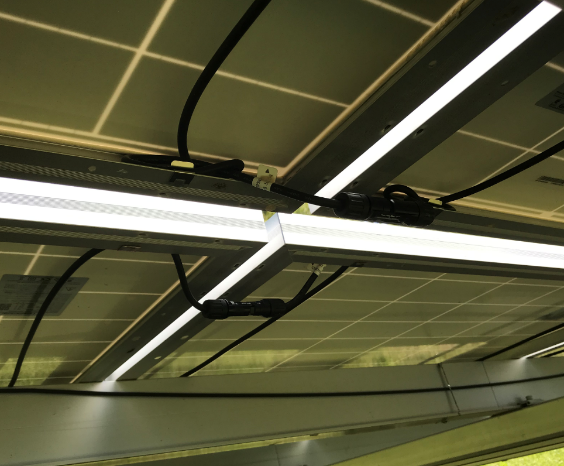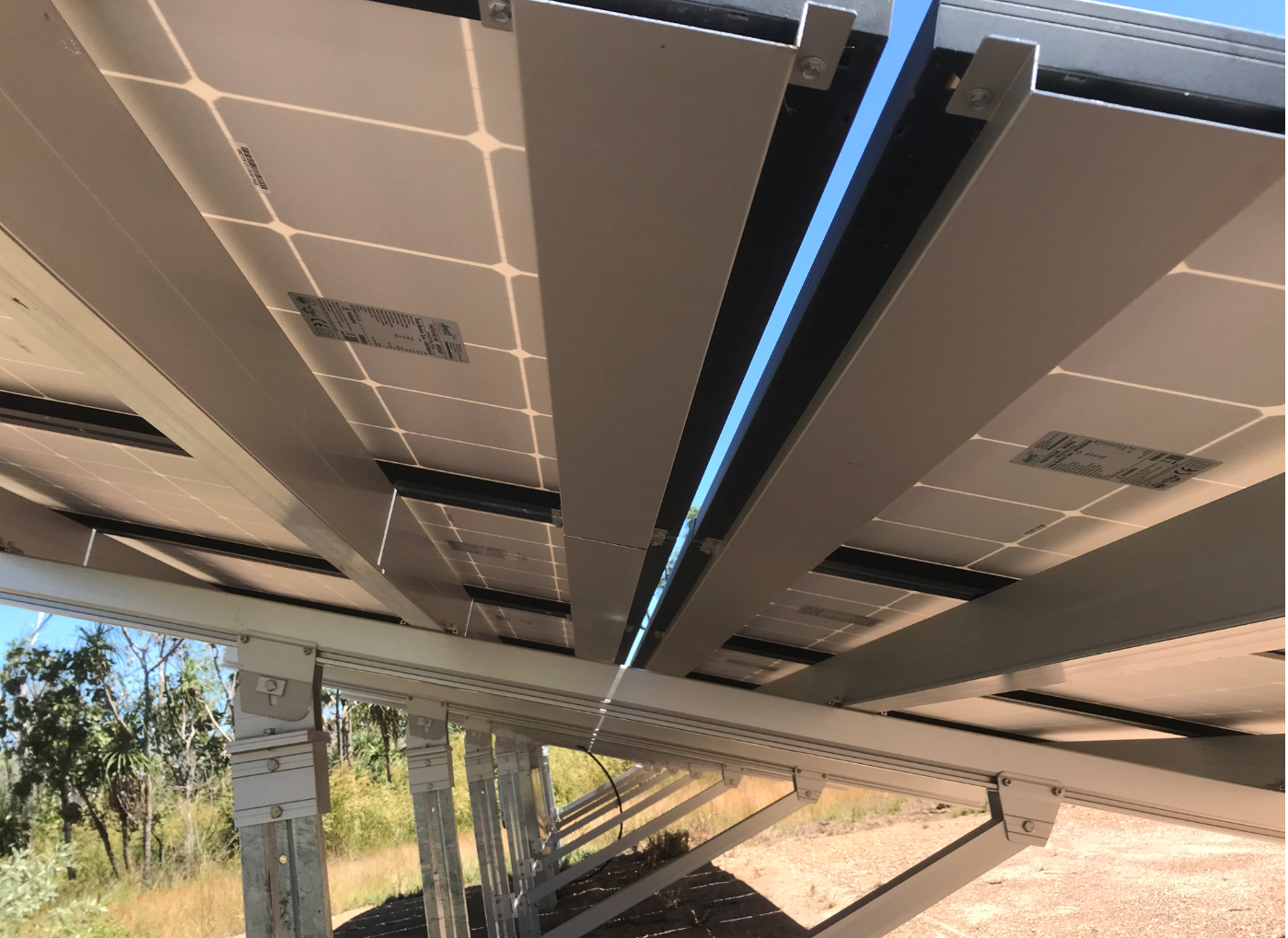Ground mounted solar PhotoVoltaic arrays
Ground mounted solar PhotoVoltaic arrays safety and maintenance.

Installation safety and protection
A ground mounted solar Photovoltaic (PV) array is a solar energy generator that is mounted on the ground using a specially designed frame or approved framed structure. These arrays are commonly used where there are no suitable building structures located in the area on which to mount the array.
Solar PV ground mount arrays are a building structure and are subject to the NT Building Act 1993.
These types of solar arrays are located close to the ground where the panels, electrical cables and components can be easily reached by persons and animals. e.g., children swinging on the cables or animals chewing the insulation of the cables.
Damage to any part of the array can present significant safety risks from the energy generated by the solar panels. A damaged array may also result in lower generation, additional maintenance and a shorter life expectancy of the array.
Depending on the design of the solar PV system, the generated voltage can be up to 1500 volts DC and will generally have sufficient current to cause death, significant injury and burns. Breakage of the cables can result in an electric arc (spark) that can burn the skin and start fires if there is dry grass or other flammable materials nearby.
The following details the requirements of Australian Standards and the Electrical Safety Act 2022 and Electrical Safety Regulations 2024, legislative references are provided at the end of this document.
| Unprotected cables under panels | Cables protected by ducting |
|---|---|
 |  |
New Requirements of AS/NZS 5033:2021.
Clause 1.3.37 defines restricted access as:
- by a barrier (e.g. by a perimeter fence or barrier with access only via a padlocked or equivalently secured gate or door).
- by location (e.g. roof where there is no fixed ladder or other ready means of access).
- by enclosure (e.g. cables in a wiring enclosure that are not accessible without the use of a tool).
- by installation height - greater than 2.5 m above the ground, floor or platform.
Clause 4.3.2.3.2 Restricted access for PV modules:

Requirements of AS/NZS 3000:2018 Wiring Rules
Clause 1.5.1 Protection against dangers and damage:
All cabling and components of the array are required to meet the fundamental principles of protection against dangers and damage defined in this standard, and be enclosed with conduit, ducting, covered cable tray or similar to prevent damage to or contact with any of the cables or components.
Requirements of Electrical Safety Act 2022.
Section 29 Safety duty of installers:
A person who installs a ground mount solar system must ensure that the system is installed in a manner that is safe from electrical risk and in accordance with the Electrical Safety Regulations 2024 and Australian Standards.
Section 31 Safety duty of owner or operator of installation:
To achieve and maintain a safe ground mounted solar PV array as required by owners or operators of electrical installations, we recommend that a risk assessment be conducted to identify the additional risks presented and to define the requirements of protecting against the effects of injury and/or damage.
Requirements of the Electrical Safety Regulations 2024
Regulation 136 Standards
A person performing electrical work involving a photovoltaic array must perform the work in accordance with the Act and Regulations, and Australian Standards called up by the regulations.
These standards include:
- The AS/NZS 3000:2018 Wiring Rules.
- AS/NZS 5033 (Installation and safety requirements for photovoltaic (PV) arrays).
- AS/NZS 4777.1 (Grid connection of energy systems via inverters).
- AS/NZS 1170.2 (Structural design actions Part 2: Wind actions).
- Any requirements of the network operator applicable to photovoltaic arrays.
Regulation 137 Enclosure of photovoltaic array
This regulation applies in relation to the ownership or installation of photovoltaic arrays on and after 1 July 2026 and specifically applies to any photovoltaic array that is free standing and is less than 2.5 m from the ground surface.
The regulation specifies that the array must be enclosed in a manner that prevents:
- unauthorised access to the array; and
- damage to the array caused by animals.
The photovoltaic array is not required to be enclosed if:
- a written risk assessment is undertaken by a competent person; and
- the risk assessment shows a low risk of unauthorised access and a low risk of damage to the photovoltaic array.
Other considerations for safety.
- Children can play in an area where the array is located.
- Public can access the array.
- Animals or persons may jump onto the panels causing damage or risking a fall.
- Animals may chew or get caught on the cables or components.
- Accidental contact – mowers, vegetation clearing, vehicles or other equipment accessing the area.
________________________________________
Legislative References:
Electrical Safety Act 2022, Section 29 Safety duty of installers.
A person who installs electrical equipment or an electrical installation must ensure that:
a) it is installed in a manner that is safe from electrical risk and in accordance with the regulations; and
b) the processes followed to install it make it safe from electrical risk when installed; and
c) it is examined and tested in accordance with the regulations to be safe from electrical risk; and
d) the notifications required under the regulations are complied with.
Section 31 Safety duty of owner or operator of installation.
A person who owns or operates an electrical installation must do all that is reasonably practicable to ensure that:
- the installation complies with, and is operated in accordance with, any technical and safety requirement prescribed by regulation; and
- the installation is safe from electrical risk and safely operated and maintained.
Electrical Safety Regulations 2024, Regulation 136 Standards.
1) A person performing electrical work involving a photovoltaic array must perform the work in accordance with this regulation.
2) The electrical work must comply with the following:
a) the Wiring Rules;
b) AS/NZS 5033 (Installation and safety requirements for photovoltaic (PV) arrays);
c) AS/NZS 4777.1 (Grid connection of energy systems via inverters);
d) AS/NZS 1170.2 (Structural design actions Part 2: Wind actions);
e) any requirements of the network operator applicable to photovoltaic arrays;
f) any requirements for construction applicable in high wind areas under the Building Code as adopted under the Building Regulations 1993.
Note for subregulation (2)(f): The Building Code sets out high wind areas and refers to Wind Region C (cyclonic) as defined in AS/NZ 1170.2.
3) A person commits an offence if the person contravenes subregulation (1).
Maximum penalty: 50 penalty units.
4) An offence against subregulation (3) is an offence of strict liability.
Regulation 137 Enclosure of photovoltaic array.
1) This regulation applies in relation to the ownership or installation of photovoltaic arrays on and after 1 July 2026.
2) Subject to subregulation (3), any photovoltaic array that is free standing and is less than 2.5 m from the ground surface must be enclosed in a manner that prevents:
a) unauthorised access to the array; and
b) damage to the array caused by animals.
3) The photovoltaic array is not required to be enclosed if:
a) a written risk assessment is undertaken by a competent person; and
b) the risk assessment shows a low risk of unauthorised access and a low risk of damage to the photovoltaic array.
4) A person commits an offence if the person:
a) owns or installs a photovoltaic array that is free standing and is less than 2.5 m from the ground surface; and
b) does not enclose the photovoltaic array in accordance with subregulation (2).
Maximum penalty: 50 penalty units.
5)An offence against subregulation (4) is an offence of strict liability.